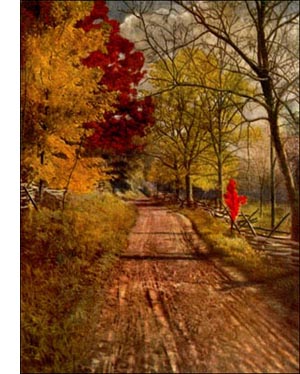Aspen or Quaking Aspen Poplar Tree
 Aspen, or Quaking Asp (Populus tremuloides, Michx.)Slender tree, 40 to 80 feet high, with angular, scarred twigs, and large, vigorous roots. Bark rough, dark on base of trunk, becoming pale greenish brown or nearly white, and marked with broad, dark bands below the limbs. Wood light brown, sap wood White, soft, close grained, light, weak, not durable. Buds waxy, conical, scaly, brown. Leaves alternate, simple, 1 1/2 to 2 1/2 inches long, ovate or almost round, with straight base and apex acute; margin faintly toothed; thin, shining green above, dull yellowgreen beneath; autumn colour yellow; petiole flattened, flexible, slender. Flowers in April, dioecious; catkins pendulous, 1 1/2 to 2 1/2 inches long, each flower on notched bract, fringed with hairs; stamens 6 to 12 on disc; ovary conical; stigmas 2-lobed; disc broad, persistent. Fruits, May, borne in drooping aments, 4 inches long; capsules oblong-conical, 2-valved, pale green; seeds oblong, covered with brush of long white hairs. Preferred habitat, sandy or gravelly soil, dry or moist. Distribution, Newfoundland to Hudson Bay and Alaska; south to New Jersey, Pennsylvania, Kentucky, Nebraska; also high altitudes throughout the Rocky Mountains and coast ranges. Uses: Most valuable cover for forest land devastated by fire. Comes up from seed scattered broadcast by wind, an,,! acts as nurse to hardwoods and conifers that later succeed them. A pretty shade and ornamental tree, though short lived.
Aspen, or Quaking Asp (Populus tremuloides, Michx.)Slender tree, 40 to 80 feet high, with angular, scarred twigs, and large, vigorous roots. Bark rough, dark on base of trunk, becoming pale greenish brown or nearly white, and marked with broad, dark bands below the limbs. Wood light brown, sap wood White, soft, close grained, light, weak, not durable. Buds waxy, conical, scaly, brown. Leaves alternate, simple, 1 1/2 to 2 1/2 inches long, ovate or almost round, with straight base and apex acute; margin faintly toothed; thin, shining green above, dull yellowgreen beneath; autumn colour yellow; petiole flattened, flexible, slender. Flowers in April, dioecious; catkins pendulous, 1 1/2 to 2 1/2 inches long, each flower on notched bract, fringed with hairs; stamens 6 to 12 on disc; ovary conical; stigmas 2-lobed; disc broad, persistent. Fruits, May, borne in drooping aments, 4 inches long; capsules oblong-conical, 2-valved, pale green; seeds oblong, covered with brush of long white hairs. Preferred habitat, sandy or gravelly soil, dry or moist. Distribution, Newfoundland to Hudson Bay and Alaska; south to New Jersey, Pennsylvania, Kentucky, Nebraska; also high altitudes throughout the Rocky Mountains and coast ranges. Uses: Most valuable cover for forest land devastated by fire. Comes up from seed scattered broadcast by wind, an,,! acts as nurse to hardwoods and conifers that later succeed them. A pretty shade and ornamental tree, though short lived.Aspen is a general term applied to trees of this genus whose leaves have flattened stems. The round-stemmed ones are poplars, proper. The Russian adage: "There is a tree that trembles without even a breath of wind," might well fit this most apprehensive of all the aspen trees. Its dainty round leaf blades twinkle in the sun, a grove of the trees together producing at a little distance the appearance as well as the sound of rippling water. It is the gayest of trees. That was a lugubrious wight who imagined it accursed by being the tree on which Judas Iscariot hanged himself, and doomed "ever afterward to shudder and tremble on account of its connection with the tragedy of Calvary." The same legend attaches to the pretty little redbud, the Judas tree.
"The green wood moved, and the light poplar shook
Its silver pyramid of leaves."
We might easily adapt these graceful lines to our quaking asp, but that the word "silver" will not apply accurately. The English poet, Barry Cornwall, was describing the white poplar with white leaf linings.
There is no mystery in the trembling of these aspen leaves. Examine one. The stem is long and flexible. It is flattened in a plane at right angles with the blade of the leaf. Now, given a leaf that is dangling from its twig, and has four flat surfaces exposed, it is, a cautious breeze indeed that is able to get by without disturbing the leaf's unstable equilibrium. Given, a treetop of leaves similarly made and hung, and you have a quaking asp. It waves you an invitation to examine, and see if the explanation above is not correct.
Homer's famous simile based on the leaves of poplar trees is not ungallant as that of Gerarde, who compares them to "women's tongues which seldom cease wagging."
The most delicate colouring is found in this aspen tree. The pale bark takes on a cool, greenish tinge in earliest spring. The furry catkins flush pink with their silvery grey silk. The opening leaves unroll, soft and white, like flannel-"ju" luk a kitten's ear," each one of them, to quote Uncle Eb. They pass through various tones of rose and olive on the way to their lustrous adult stage. Every day from early March till May it is worth while to go by a copse of trembling aspen and look up to see what new phase of the trees' life history has opened since last we passed that way.